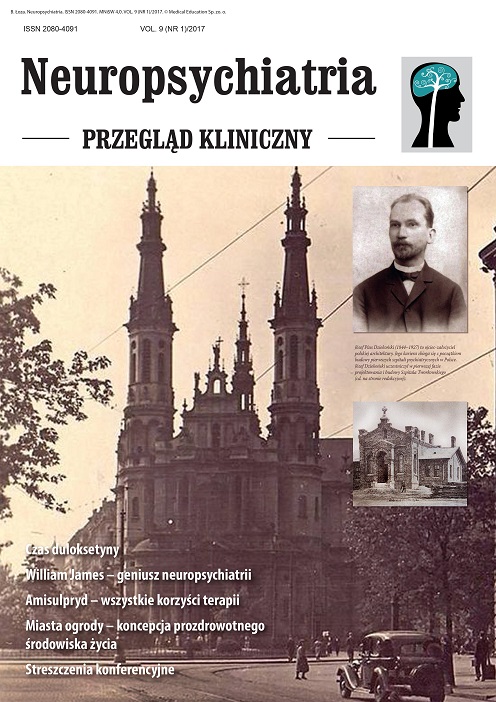Dlaczego warto wybrać duloksetynę? Artykuł przeglądowy
##plugins.themes.bootstrap3.article.main##
Abstrakt
Duloksetyna jest jednym z najczęściej stosowanych, pierwszorzutowych leków przeciwdepresyjnych. Jest przedstawicielem klasy SNRI leków przeciwdepresyjnych, czyli selektywnych inhibitorów wychwytu zwrotnego serotoniny i noradrenaliny. Ponadto, choć w nieco mniejszym stopniu, hamuje także wychwyt zwrotny dopaminy. Najważniejszymi wskazaniami do stosowania duloksetyny są: zaburzenia depresyjne (tzw. duża depresja), zespół lęku uogólnionego oraz ból neuropatyczny.
##plugins.themes.bootstrap3.article.details##

Utwór dostępny jest na licencji Creative Commons Uznanie autorstwa – Użycie niekomercyjne – Bez utworów zależnych 4.0 Międzynarodowe.
Copyright: © Medical Education sp. z o.o. License allowing third parties to copy and redistribute the material in any medium or format and to remix, transform, and build upon the material, provided the original work is properly cited and states its license.
Address reprint requests to: Medical Education, Marcin Kuźma (marcin.kuzma@mededu.pl)
Bibliografia
2. Waitekus AB, Kirkpatrick P. Fresh form the pipeline. Duloxetine hydrochloride. Nat Rev Drug Discov 2004; 3(11): 907-908.
3. Tran PV, Bymaster FP, McNamara RK, Potter WZ. Dual Monoamine Modulation for Improved Treatment of Major Depressive Disorder. J Clin Psychopharm 2003; (23): 78-86.
4. Chen Z, Yang J, Tobak A. Designing new treatments for depression and anxiety. IDrugs: the investigational drugs journal 2008; 11(3): 189-197.
5. Hrenchir T. Newsmax Health.
6. CHPL. Charakterystyka Produktu Leczniczego .
7. Cipriani A, Koesters M, Furukawa TA et al. Duloxetine versus other anti-depressive agents for depression. Cochrane Database Syst Rev 2012; 10: CD006533.
8. Yamashita T, Yamamoto S, Zhang J et al. Duloxetine Inhibits Microglial P2X4 Receptor Function and Alleviates Neuropathic Pain after Peripheral Nerve Injury. PLoS One 2016; 11(10): e0165189.
9. Carter NJ, McCormack PL. Duloxetine: a review of its use in the treatment of generalized anxiety disorder. CNS Drugs 2009; 23(6): 523-541.
10. Hong J, Novick D, Montgomery W et al. Health-related quality of life in patients with depression treated with duloxetine or a selective serotonin reuptake inhibitor in a naturalistic outpatient setting. Patient Prefer Adherence 2015; 9: 1481-1490.
11. Cheon EJ, Lee JY, Choi JH et al. Effectiveness of Duloxetine Monotherapy Compared to Combination Therapy with Other Antidepressants in Patients with Major Depressive Disorder: A Short-Term, Retrospective Study. Psychiat Invest 2016; 13(4): 447-452.
12. Dell’osso B, Camuri G, Dobrea C et al. Duloxetine in affective disorders: a naturalistic study on psychiatric and medical comorbidity, use in association and tolerability across different age groups. Clin Pract Epidemiol Ment Health 2012; 8: 120-125.
13. Arnold LM, Blom TJ, Welge JA et al. A randomized, placebo-controlled, double-blinded trial of duloxetine in the treatment of general fatigue in patients with chronic fatigue syndrome. Psychosomatics 2015 May-Jun; 56(3): 242-253. https://doi.org/10.1016/j.psym.2014.12.003.
14. Mancini M, Perna G, Rossi A, Petralia A. Use of duloxetine in patients with an anxiety disorder, or with comorbid anxiety and major depressive disorder: a review of the literature. Expert Opin Pharmacother 2010; 11(7): 1167-1181.
15. Zhang M, Li H, Ji Z et al. Clinical study of duloxetine hydrochloride combined with doxazosin for the treatment of pain disorder in chronic prostatitis/chronic pelvic pain syndrome: An observational study. Medicine (Baltimore) 2017; 96(10): e6243.10.1097/MD.
16. Ren WW, Zhou ZY, Xu MM et al. Treatment of Persistent Somatoform Pain Disorder by Floating Needle Therapy and Duloxetine. Zhongguo Zhong Xi Yi Jie He Za Zhi 2016; 36(2): 166-171.
17. FDA. 01.04.2017.
18. Clayton A, Kornstein S, Prakash A et al. Changes in sexual functioning associated with duloxetine, escitalopram, and placebo in the treatment of patients with major depressive disorder. J Sex Med 2007; 4(4): 917-929.

